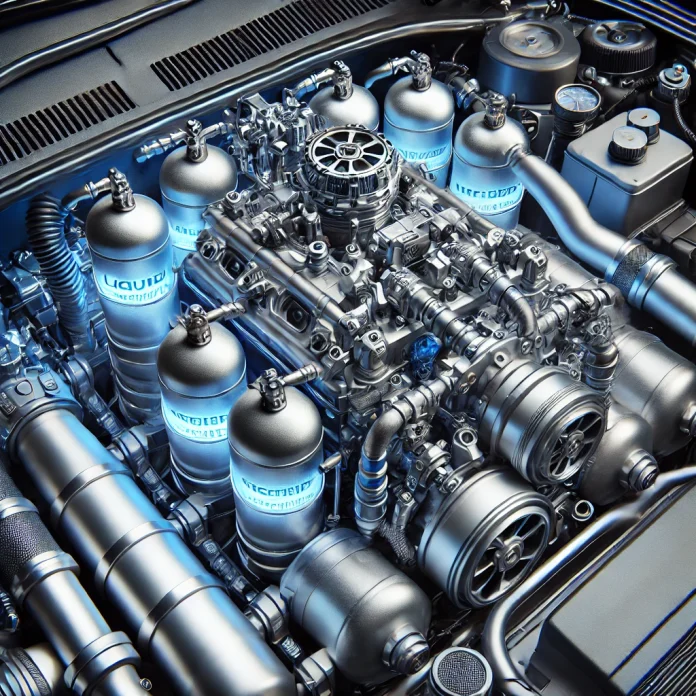When it comes to alternative fuels, the focus has largely been on electric, hydrogen, and biofuels. However, there’s another lesser-known contender that has been quietly developing in the shadows: liquid nitrogen (LN₂). With its zero emissions and unique thermodynamic properties, liquid nitrogen offers a compelling case as a sustainable energy carrier. In this blog post, we’ll explore the technical specifications, existing prototypes, and the opportunities and challenges of using liquid nitrogen as a fuel for automotive engines.
What is Liquid Nitrogen?
Liquid nitrogen is nitrogen gas cooled to an extremely low temperature of -196°C (-321°F), at which point it becomes a liquid. It is widely used in industries for cooling, freezing, and cryogenic storage. As a potential automotive fuel, liquid nitrogen is not a source of energy in itself but an energy carrier that exploits the expansion of nitrogen gas when it transitions from liquid to gas.
When liquid nitrogen absorbs heat, it expands 696 times its original volume, creating pressure that can be used to power a piston or turbine. This expansion process makes LN₂ a viable candidate for powering automotive engines, especially in scenarios where zero emissions are critical.
How Does a Liquid Nitrogen Engine Work?
A liquid nitrogen engine relies on a simple process of cryogenic expansion:
- Cryogenic Storage:
Liquid nitrogen is stored in a highly insulated tank within the vehicle to maintain its low temperature and minimize losses from evaporation. - Heat Exchanger:
The liquid nitrogen is exposed to a heat source, such as ambient air or waste heat from the vehicle. This heat causes the LN₂ to vaporize and expand into nitrogen gas. - Energy Conversion:
The expanding gas drives a piston or turbine, converting the pressure into mechanical energy to power the vehicle.
Unlike traditional fuels, this process doesn’t involve combustion, making it a zero-emission technology. The only exhaust product is nitrogen gas, which constitutes about 78% of the Earth’s atmosphere.

Technical Specifications
Here are some key technical characteristics of liquid nitrogen as a fuel:
| Property | Value |
|---|---|
| Energy Density | ~0.2 kWh/kg (compared to 12 kWh/kg for gasoline) |
| Expansion Ratio | 1:696 (liquid-to-gas volume) |
| Storage Temperature | -196°C (-321°F) |
| Thermodynamic Efficiency | ~20-25% (dependent on engine design) |
| Environmental Impact | Zero emissions; nitrogen gas is the only byproduct |
Prototypes and Projects
1. The Dearman Engine
The Dearman Engine, developed by Peter Dearman in the UK, is one of the most notable examples of LN₂-powered technology. Designed initially for refrigerated delivery trucks, this engine uses liquid nitrogen to power both the vehicle and its refrigeration system. It operates by capturing waste heat from its surroundings, improving overall efficiency.
- Performance: Demonstrated to be a feasible alternative to diesel-powered refrigeration units.
- Applications: Ideal for urban delivery vehicles where emissions and noise are major concerns.
2. LN₂-Powered Urban Cars
Researchers at Universidad Politécnica de Cataluña (Spain) developed a prototype car powered exclusively by liquid nitrogen. While the vehicle had a limited range of around 20-30 km (12-18 miles) and a top speed of 50 km/h (31 mph), it highlighted the potential for LN₂ in small, low-speed urban applications.
3. Hybrid Systems
Experimental hybrid systems combine liquid nitrogen with electric motors or traditional fuels. LN₂ serves as a range extender or energy booster during peak demands. This approach improves efficiency and compensates for the low energy density of LN₂.
Opportunities for Liquid Nitrogen as a Fuel
Liquid nitrogen presents several unique advantages that could make it a valuable alternative fuel in specific scenarios:
- Zero Emissions:
The exhaust is pure nitrogen gas, making LN₂-powered vehicles completely emission-free. - Safety:
Liquid nitrogen is non-flammable, non-toxic, and poses no risk of explosion, unlike compressed hydrogen or natural gas. - Cooling Effect:
LN₂ absorbs heat as it vaporizes, providing a cooling effect that is especially beneficial in hot climates or for refrigerated transport. - Silent Operation:
LN₂-powered engines produce minimal noise, making them ideal for urban and residential areas. - Recycling Waste Heat:
Waste heat from industrial processes or other vehicle components can be used to vaporize LN₂, increasing efficiency.
Challenges
Despite its advantages, liquid nitrogen faces significant barriers to widespread adoption:
- Low Energy Density:
LN₂’s energy density is far lower than that of gasoline, diesel, or even hydrogen. This results in limited range and frequent refueling. - Energy-Intensive Production:
Producing liquid nitrogen requires significant energy, often derived from electricity. If this electricity comes from non-renewable sources, the environmental benefits diminish. - Cryogenic Infrastructure:
Storing and transporting liquid nitrogen requires specialized insulated tanks and cryogenic refueling infrastructure, which is costly to implement at scale. - Thermal Losses:
Even in insulated tanks, LN₂ slowly warms up and evaporates, leading to energy loss over time. - Efficiency:
The thermodynamic efficiency of LN₂ engines is relatively low, making them less competitive with electric or internal combustion engines in most applications.

Future Potential
While liquid nitrogen is unlikely to replace mainstream fuels like gasoline or electricity, it holds promise for niche applications:
- Refrigerated Delivery Trucks: Combining propulsion and refrigeration in a single zero-emission system.
- Urban Transport: Short-distance, low-speed vehicles where emissions and noise are critical concerns.
- Energy Storage Systems: LN₂ could serve as a complementary storage medium for renewable energy, particularly in hybrid systems.
Conclusion
Liquid nitrogen as a fuel for automotive engines offers an exciting glimpse into a future of clean mobility. While it faces challenges such as low energy density and infrastructure requirements, its zero emissions, safety, and unique thermodynamic properties make it a promising solution for specific use cases. As technology advances and renewable energy becomes more widespread, LN₂ could carve out a niche in the growing landscape of alternative fuels.
The road ahead for liquid nitrogen is still being paved, but its potential is undeniable. Whether it becomes a mainstream fuel or a specialized solution, liquid nitrogen is an innovation worth keeping an eye on.













